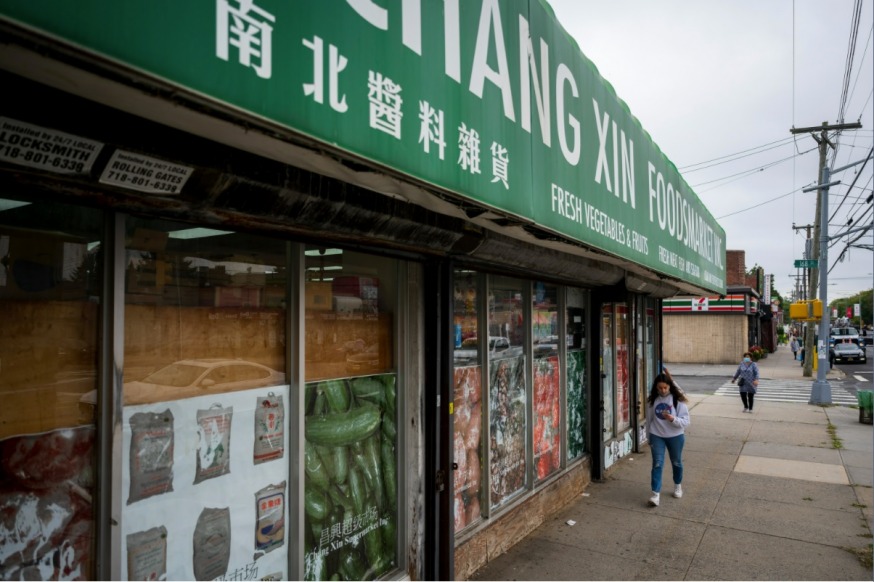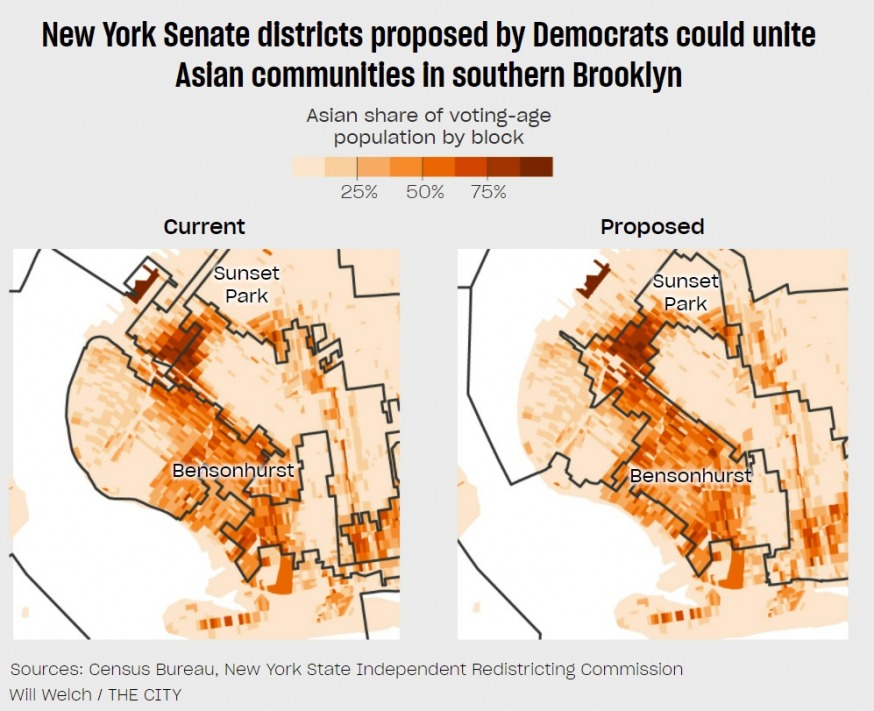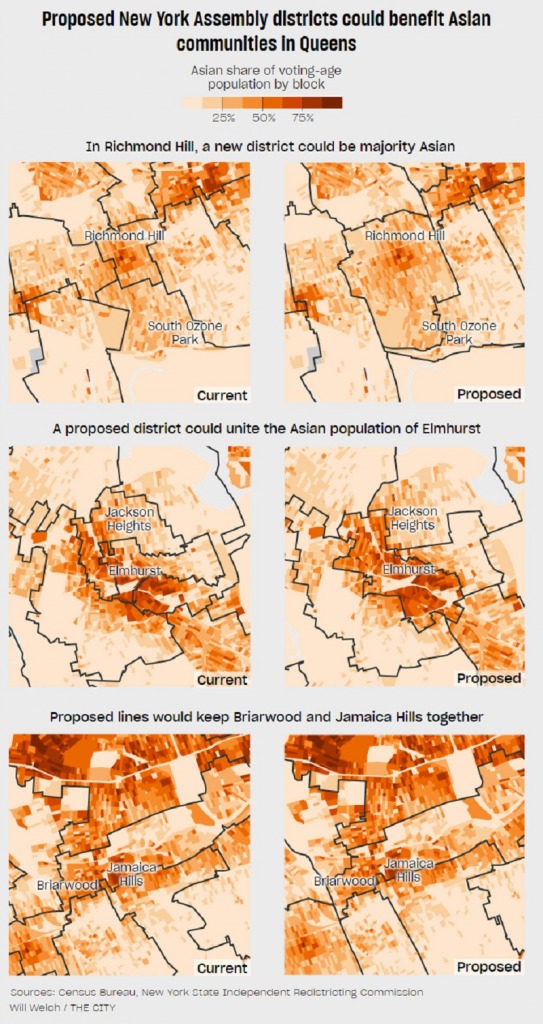
Pedestrians walk past a market at the intersection of Union Turnpike and 168th St in Hillcrest, Queens, Sept. 17, 2021. | Hiram Alejandro Durán/THE CITY

This article was originally published
by The CITY on Oct. 3
BY
When the state’s new Independent Redistricting Commission split along party lines and put out dueling maps in mid-September, attention focused on clashing visions for congressional boundaries with the House of Representatives up for grabs last year.
Not as widely noticed were two versions of maps for the state Legislature — including a Democratic-crafted edition that would create four districts in the city where the growing ranks of Asian New Yorkers represent a majority or plurality of residents.
The maps are preliminary — and the out-of-the-gate war being waged by the 10 members of the supposedly nonpartisan commission bodes for a messy process that ultimately could get tossed to the Democrat-dominated state Legislature.
Still, some local Asian-American leaders see hopes for a political coming of age.
The Democrats’ map reflects “responsive action to address the concerns of the Asian American community consistent with the Voting Rights Act and the need to keep communities of interest together,” said Elizabeth OuYang, who coordinates a redistricting task force made up of 20 Asian community groups across the city.
Activists in Brooklyn and Queens –– where the Asian population has grown by nearly 43% and 29%, respectively, since 2010 –– have been lobbying the new state commission to redraw district lines to unite neighborhoods with high numbers of Asian residents into single districts.
There are currently several areas in the two boroughs that divide Asian population centers into various state Assembly and Senate districts. The fragmentation leads to struggles to capture the attention of elected officials — makes it harder to get public services, activists argue.
The once-in-a-decade redrawing, fueled by last year’s census, spurred legislative maps for the city in which Republicans left things largely the same while the Democrats proposed some districts where Asians New Yorker represent a majority or plurality:
- —A state Assembly slot to serve Richmond Hill and South Ozone Park
- —An Assembly slot to serve Briarwood and Jamaica Hills
- —An Assembly slot to serve Elmhurst
- —A state Senate seat for Sunset Park and Bensonhurst
‘Keeps the Neighborhood Whole’
In Brooklyn, a borough with no Asian elected state officials, map makers proposed a state Senate district where Asian residents would make up 45% of the population. Activists sought to seize upon significant Asian population growth in southern Brooklyn neighborhoods to create the borough’s first Asian-majority district.

Many states, including New York, directly encourage that communities of interest — groups of voters likely to share political priorities — remain together when election district maps are drawn.
“From a neighborhood that is currently divided into four Senate districts, we now see more consolidated representation that keeps the neighborhood whole along with communities of interest in Bensonhurst,” said Mon Yuck Yu, vice president and chief of staff of the Academy of Medical and Professional Health Services, a nonprofit based in Sunset Park.
Over the past decade, the number of Asian residents in Brooklyn increased by more than 110,000, to nearly 371,000, far outpacing any other racial group, U.S. Census figures show.
Yet, nonprofits and civic groups told THE CITY that it’s hard to get the ear of elected officials as Asian residents are outnumbered in every single Assembly and Senate district as currently drawn in Brooklyn.
“There is a possibility to create the first Asian-majority district in Brooklyn. However, these lines are still short of doing so. We will work with the commission in the coming months to explore the implications of the 43% growth in Asian population in Brooklyn,” said Yu.
‘Hard to Fathom’
In Queens’ Richmond Hill, the first draft of maps proposed by Democratic appointees to the commission created an Assembly district with a majority of Asian residents, including many with Guyanese or Trinidadian heritage. Another Assembly district in Elmhurst could serve a majority-Asian population. And a district in Briarwood and Jamaica Hills proposes to keep various South Asian neighborhoods together.

But organizers said the commission’s lines are far from perfect and some took issue with several state Senate districts in Queens. One district drawn by the Democrats has a significant number of Black and Latino residents, but includes a portion of Richmond Hill with a large Asian resident population.
“We are concerned about the Senatorial district formulation, which further politically disenfranchises the voices of Richmond Hill,” Mohamed Amin, executive director of the Caribbean Equality Project, said in a statement.
Activists were also frustrated with an oddly shaped proposed southeast Queens state Senate district. As proposed, 42% of the district, which keeps a uniformed shape before jutting out westwards in a “T” formation, is populated by Asian residents. A local activist says the commission should go further and make it an outright majority.
“It is hard to fathom why the same South Asian communities of interest are kept whole in Assembly district maps, but cannot be kept whole in the Senate,” said John Albert, who leads Taking Our Seat, a Queens-based redistricting group focused on uniting South Asian residents.
Too Soon to Tell
In the last redistricting cycle, Assembly Democrats were in control of creating the chamber’s maps and crafted lines that were favorable for incumbents. The new map of Assembly districts praised by activists would also mean changing at least nine current districts. THE CITY reached out to incumbent Assembly members there, and only one responded.
Assemblywoman Nily Rozic, a Democrat whose Fresh Meadows/Flushing/Bayside district is already majority Asian, told THE CITY that community groups should continue to be listened to as the process continues.
“As the Redistricting Commission works to find consensus on new maps, I hope that proper input is sought out and taken seriously,” said Rozic, who was first elected in 2012. “Community-based organizations and good-government groups have put in tireless work analyzing census data and can provide meaningful insights that will ensure fair representation for all New Yorkers.”
If Albany lawmakers take over the process, it’s unclear what their priorities for the new districts would be. Many lawmakers aren’t weighing in yet.
State Sen. John Liu — a Queens Democrat whose district was redrawn in the preliminary round in a way that activists say divides some Korean-American enclaves — told THE CITY that it’s too early in the map making process for him and his colleagues to weigh in.
“The maps as released are extremely preliminary,” said Liu, who was one of the first two Asian-Americans elected to the Senate. “They are so preliminary that I don’t even think about them.”
He added the state Legislature has the right to make changes regardless.
“To me, whatever the districts are at the end of the day are what they are,” said Liu, before adding: “It’s up to the Legislature to approve the final lines.”
Incumbents Could Hold Key
On the state Senate side, a pair of incumbents — Diane Savino and Zellnor Myrie — previously told THE CITY that they believed that the way lines are currently drawn in southern Brooklyn neighborhoods with a significant number of Asian residents is unfair.
Brooklyn Sen. Simcha Felder, whose district includes Borough Park and Midwood, bith home to growing Asian populations, said he was fine with how his district currently is.
The early dysfunction could embolden Democrats in the state Legislature to take over the process from the commission. To do this, the Legislature will have to reject the final maps twice.
The commission will kick off a second series of 14 public hearings on Oct. 20, The commissioners will then distill that input into a new version of the maps. It remains to be seen whether the Democratic and GOP appointees to the commission will put forward a single set of maps this time, rather than competing ones again.
The stakes are high for New York, one of the few states where Democrats have a back-door option to take control and draw favorable lines ahead of a battle for the House of Representatives in 2022. New York is already losing one House seat based on new census results and Republican states like Texas and Georgia are moving to create favorable lines.
THE CITY is an independent, nonprofit news outlet dedicated to hard-hitting reporting that serves the people of New York.






